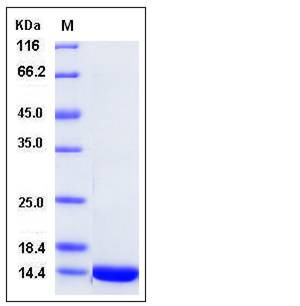Human Thioredoxin / TXN / SASP Protein
DKFZp686B1993,MGC61975,RP11-427L11.1,TRDX,TRX,TRX1,TXN
- 100ug (NPP4309) Please inquiry
| Catalog Number | P10384-HNAE |
|---|---|
| Organism Species | Human |
| Host | E. coli |
| Synonyms | DKFZp686B1993,MGC61975,RP11-427L11.1,TRDX,TRX,TRX1,TXN |
| Molecular Weight | The recombinant human TXN comprises 105 amino acids and predicts a molecular mass of 11.7 kDa. It migrates ass an approximately 14 kDa band in SDS-PAGE under reducing conditions. |
| predicted N | Met |
| SDS-PAGE |  |
| Purity | > 97 % as determined by SDS-PAGE |
| Protein Construction | A DNA sequence encoding the C-terminal segment of human TXN (P10599) (Met 1-Val 105) was expressed and purified. |
| Bio-activity | 1. Measured by its ability to catalyze the reduction of insulin. The specific activity is 5-9 pmoles/min/μg. 2. Measured by its ability to catalyze the reduction of insulin. The reaction leads toprecipitation, which can be measured by absorbance at 650 nm. The specific activity is 5-10 A650/min/mg. |
| Research Area | Immunology |Signal Transduction |Metabolism |Pathways and Processes |Metabolism processes |Apoptosis | |
| Formulation | Lyophilized from sterile PBS, pH 7.5 1. Normally 5 % - 8 % trehalose and mannitol are added as protectants before lyophilization. Specific concentrations are included in the hardcopy of COA. |
| Background | Thioredoxin, also known as ATL-derived factor, Surface-associated sulphydryl protein, SASP and TXN, is a nucleus, cytoplasm and secreted protein which belongs to the thioredoxin family. Thioredoxins are proteins that act as antioxidants by facilitating the reduction of other proteins by cysteine thiol-disulfide exchange. Thioredoxins are found in nearly all known organisms and are essential for life in mammals. Thioredoxin / TXN participates in various redox reactions through the reversible oxidation of its active center dithiol to a disulfide and catalyzes dithiol-disulfide exchange reactions. Thioredoxin / TXN plays a role in the reversible S-nitrosylation of cysteine residues in target proteins, and thereby contributes to the response to intracellular nitric oxide. Thioredoxin / TXN nitrosylates the active site Cys of CASP3 in response to nitric oxide (NO), and thereby inhibits caspase-3 activity. Thioredoxin / TXN induces the FOS/JUN AP-1 DNA-binding activity in ionizing radiation (IR) cells through its oxidation/reduction status and stimulates AP-1 transcriptional activity. |
| Reference |
